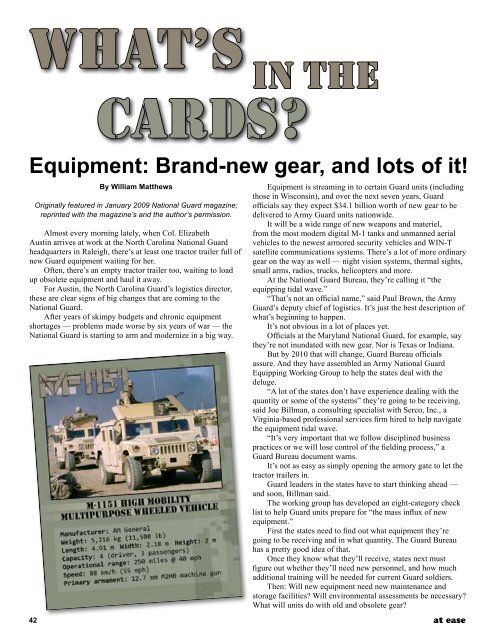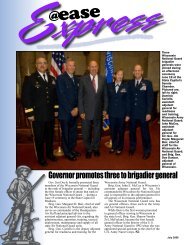At Ease - Wisconsin National Guard Department of Military Affairs
At Ease - Wisconsin National Guard Department of Military Affairs
At Ease - Wisconsin National Guard Department of Military Affairs
Create successful ePaper yourself
Turn your PDF publications into a flip-book with our unique Google optimized e-Paper software.
What’s<br />
cards?<br />
By William Matthews<br />
Originally featured in January 2009 <strong>National</strong> <strong>Guard</strong> magazine;<br />
reprinted with the magazine’s and the author’s permission.<br />
Almost every morning lately, when Col. Elizabeth<br />
Austin arrives at work at the North Carolina <strong>National</strong> <strong>Guard</strong><br />
headquarters in Raleigh, there’s at least one tractor trailer full <strong>of</strong><br />
new <strong>Guard</strong> equipment waiting for her.<br />
Often, there’s an empty tractor trailer too, waiting to load<br />
up obsolete equipment and haul it away.<br />
For Austin, the North Carolina <strong>Guard</strong>’s logistics director,<br />
these are clear signs <strong>of</strong> big changes that are coming to the<br />
<strong>National</strong> <strong>Guard</strong>.<br />
After years <strong>of</strong> skimpy budgets and chronic equipment<br />
shortages — problems made worse by six years <strong>of</strong> war — the<br />
<strong>National</strong> <strong>Guard</strong> is starting to arm and modernize in a big way.<br />
in the<br />
Equipment: Brand-new gear, and lots <strong>of</strong> it!<br />
Equipment is streaming in to certain <strong>Guard</strong> units (including<br />
those in <strong>Wisconsin</strong>), and over the next seven years, <strong>Guard</strong><br />
<strong>of</strong>ficials say they expect $34.1 billion worth <strong>of</strong> new gear to be<br />
delivered to Army <strong>Guard</strong> units nationwide.<br />
It will be a wide range <strong>of</strong> new weapons and materiel,<br />
from the most modern digital M-1 tanks and unmanned aerial<br />
vehicles to the newest armored security vehicles and WIN-T<br />
satellite communications systems. There’s a lot <strong>of</strong> more ordinary<br />
gear on the way as well — night vision systems, thermal sights,<br />
small arms, radios, trucks, helicopters and more.<br />
<strong>At</strong> the <strong>National</strong> <strong>Guard</strong> Bureau, they’re calling it “the<br />
equipping tidal wave.”<br />
“That’s not an <strong>of</strong>ficial name,” said Paul Brown, the Army<br />
<strong>Guard</strong>’s deputy chief <strong>of</strong> logistics. It’s just the best description <strong>of</strong><br />
what’s beginning to happen.<br />
It’s not obvious in a lot <strong>of</strong> places yet.<br />
Officials at the Maryland <strong>National</strong> <strong>Guard</strong>, for example, say<br />
they’re not inundated with new gear. Nor is Texas or Indiana.<br />
But by 2010 that will change, <strong>Guard</strong> Bureau <strong>of</strong>ficials<br />
assure. And they have assembled an Army <strong>National</strong> <strong>Guard</strong><br />
Equipping Working Group to help the states deal with the<br />
deluge.<br />
“A lot <strong>of</strong> the states don’t have experience dealing with the<br />
quantity or some <strong>of</strong> the systems” they’re going to be receiving,<br />
said Joe Billman, a consulting specialist with Serco, Inc., a<br />
Virginia-based pr<strong>of</strong>essional services firm hired to help navigate<br />
the equipment tidal wave.<br />
“It’s very important that we follow disciplined business<br />
practices or we will lose control <strong>of</strong> the fielding process,” a<br />
<strong>Guard</strong> Bureau document warns.<br />
It’s not as easy as simply opening the armory gate to let the<br />
tractor trailers in.<br />
<strong>Guard</strong> leaders in the states have to start thinking ahead —<br />
and soon, Billman said.<br />
The working group has developed an eight-category check<br />
list to help <strong>Guard</strong> units prepare for “the mass influx <strong>of</strong> new<br />
equipment.”<br />
First the states need to find out what equipment they’re<br />
going to be receiving and in what quantity. The <strong>Guard</strong> Bureau<br />
has a pretty good idea <strong>of</strong> that.<br />
Once they know what they’ll receive, states next must<br />
figure out whether they’ll need new personnel, and how much<br />
additional training will be needed for current <strong>Guard</strong> soldiers.<br />
Then: Will new equipment need new maintenance and<br />
storage facilities? Will environmental assessments be necessary?<br />
What will units do with old and obsolete gear?<br />
42 at ease





